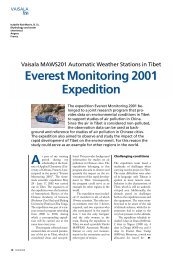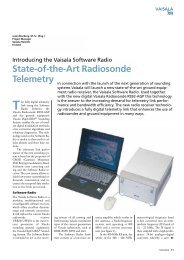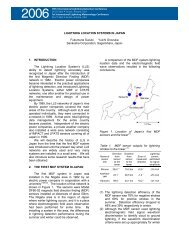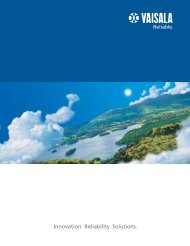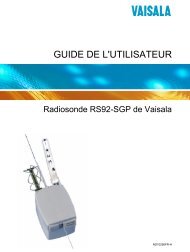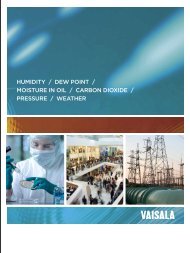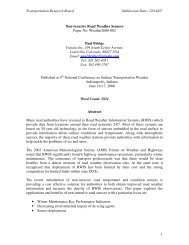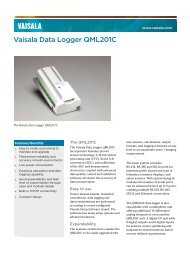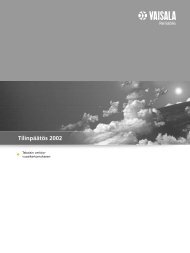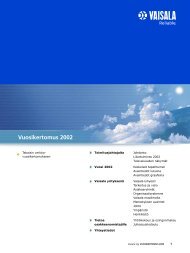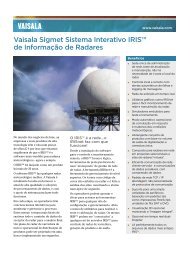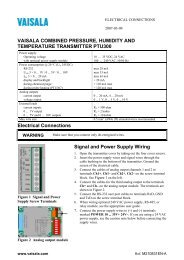humidity / dew point / tempeRAtuRe / moistuRe in oil ... - Vaisala
humidity / dew point / tempeRAtuRe / moistuRe in oil ... - Vaisala
humidity / dew point / tempeRAtuRe / moistuRe in oil ... - Vaisala
You also want an ePaper? Increase the reach of your titles
YUMPU automatically turns print PDFs into web optimized ePapers that Google loves.
Dew Po<strong>in</strong>t<br />
/ TECHNOLOGY DESCRIPTION<br />
<strong>Vaisala</strong> DRYCAP® Sensor for Measur<strong>in</strong>g<br />
Dew Po<strong>in</strong>t<br />
In 1997 <strong>Vaisala</strong> <strong>in</strong>troduced DRYCAP ® , a new type of <strong>dew</strong> <strong>po<strong>in</strong>t</strong> sensor based on th<strong>in</strong>-film polymer<br />
technology. S<strong>in</strong>ce its launch, the DRYCAP product family has grown to encompass a huge range<br />
of applications, from dry<strong>in</strong>g processes to compressed air and dry chambers. The DRYCAP sensor<br />
is particularly renowned for its reliable performance <strong>in</strong> hot and very dry environments.<br />
How It Works<br />
DRYCAP’s unrivalled performance is<br />
based on two <strong>in</strong>novations: the proven<br />
capacitive th<strong>in</strong>-film polymer sensor<br />
and the auto-calibration function.<br />
The sensor’s th<strong>in</strong>-film polymer<br />
absorbs or releases water vapor as<br />
the surround<strong>in</strong>g <strong>humidity</strong> <strong>in</strong>creases<br />
or decreases. The dielectric<br />
properties of the polymer change<br />
as the <strong>humidity</strong> around the sensor<br />
changes, as does the capacitance of<br />
the sensor. Capacitance is converted<br />
<strong>in</strong>to a <strong>humidity</strong> read<strong>in</strong>g. The<br />
capacitive polymer sensor is bonded<br />
together with a temperature sensor,<br />
and <strong>dew</strong> <strong>po<strong>in</strong>t</strong> is calculated from the<br />
<strong>humidity</strong> and temperature read<strong>in</strong>gs.<br />
<strong>Vaisala</strong>’s patented auto-calibration<br />
function optimizes the measurement<br />
stability at low <strong>dew</strong> <strong>po<strong>in</strong>t</strong>s.<br />
The sensor is heated at regular<br />
<strong>in</strong>tervals dur<strong>in</strong>g the automated<br />
auto-calibration procedure. The<br />
<strong>humidity</strong> and temperature read<strong>in</strong>gs<br />
are monitored as the sensor cools<br />
to ambient temperature, with offset<br />
correction compensat<strong>in</strong>g for any<br />
potential drift. This enables the<br />
DRYCAP sensor to deliver accurate<br />
measurements <strong>in</strong> the long term,<br />
dramatically reduc<strong>in</strong>g the need for<br />
ma<strong>in</strong>tenance.<br />
Typical Applications for<br />
Dew Po<strong>in</strong>t Measurement<br />
<strong>Vaisala</strong> DRYCAP <strong>dew</strong> <strong>po<strong>in</strong>t</strong><br />
<strong>in</strong>struments measure <strong>dew</strong> <strong>po<strong>in</strong>t</strong> <strong>in</strong><br />
<strong>in</strong>dustrial applications, where gas<br />
<strong>humidity</strong> is typically very low. Dew<br />
<strong>po<strong>in</strong>t</strong> is often a critical parameter,<br />
with <strong>in</strong>adequate control result<strong>in</strong>g <strong>in</strong><br />
problems such as process downtime,<br />
damaged process equipment, and<br />
deterioration <strong>in</strong> end-product quality.<br />
Dew <strong>po<strong>in</strong>t</strong> is measured <strong>in</strong> various<br />
dry<strong>in</strong>g and heat-treatment processes.<br />
It is also controlled <strong>in</strong> compressed<br />
air, where excess moisture can result<br />
<strong>in</strong> poor end-product quality, ice<br />
formation, and equipment corrosion.<br />
DRYCAP <strong>in</strong> Brief<br />
▪<br />
▪<br />
▪<br />
▪<br />
Th<strong>in</strong>-film polymer sensor with<br />
unique auto-calibration function<br />
Wide measurement range, <strong>dew</strong><br />
<strong>po<strong>in</strong>t</strong> measurement down to<br />
-80 °C (-112 °F)<br />
Accuracy ± 2 °C (± 3.6 °F)<br />
NIST-traceable <strong>dew</strong> <strong>po<strong>in</strong>t</strong><br />
measurement<br />
DRYCAP’s Unique Benefits<br />
▪<br />
▪<br />
▪<br />
▪<br />
Excellent long-term stability,<br />
with recommended 2-year<br />
calibration <strong>in</strong>terval<br />
Rapid response time<br />
Withstands condensation and<br />
recovers rapidly<br />
Resistant to particulate<br />
contam<strong>in</strong>ation, <strong>oil</strong> vapor, and<br />
most chemicals<br />
74




